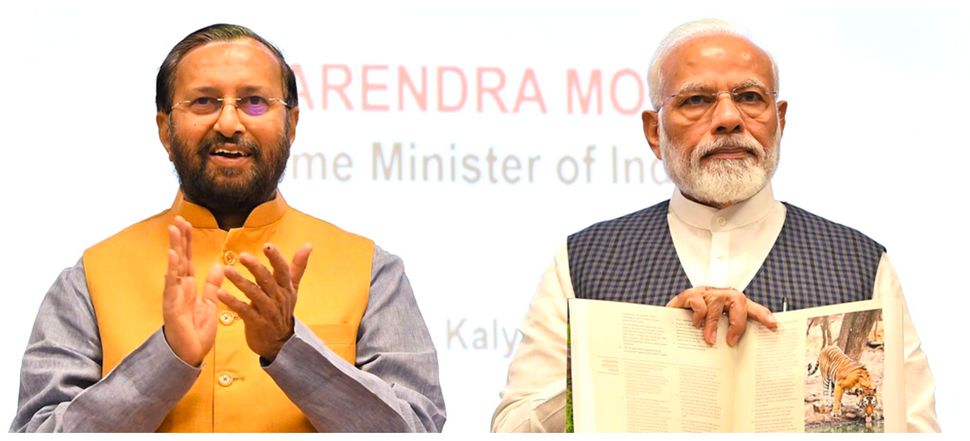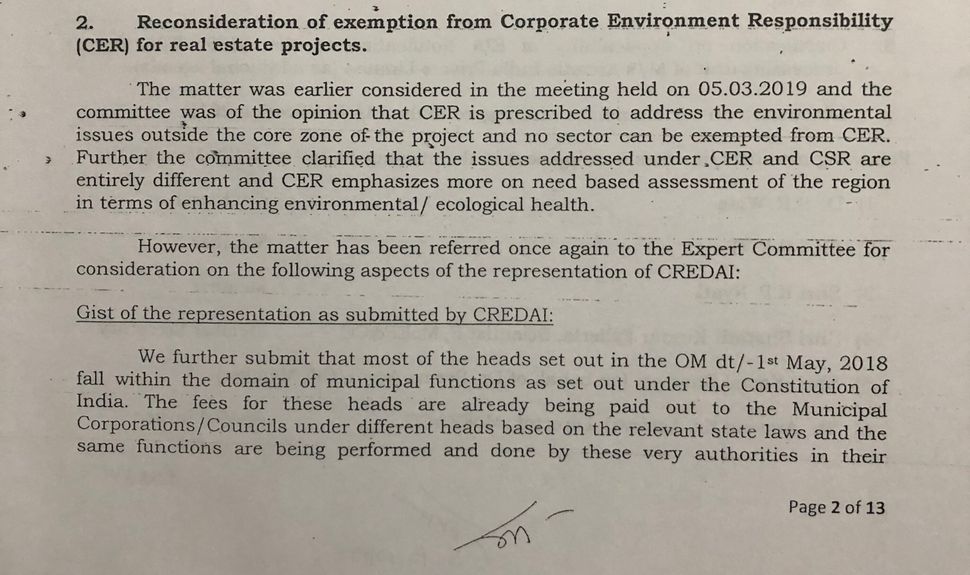
NEW DELHI—The Narendra Modi government’s controversial new draft law for environment clearance opens a window for real estate developers to avoid spending on activities that help the people and environment adversely affected by their projects, which is currently mandatory under the Corporate Environment Responsibility (CER) guidelines.
This is because the revised definition of CER in the proposed law—known as the draft Environment Impact Assessment Notification 2020—restricts its scope and makes it ambiguous, according to environmental law experts and official documents reviewed by HuffPost India.
While currently the CER is an additional expense mandatory for developers, under the new law it has been subsumed under the Environment Management Plan (EMP).
The EMP refers to a document submitted by the developer that describes the measures it has to take to lessen any adverse impact on the environment caused by the project. It is a part of the compulsory environment impact assessment (EIA) process, which is done before any project is given the go ahead.
Mumbai-based lawyer Lara Jesani told HuffPost India that since the draft law doesn’t specify if the CER will continue to be counted as a separate expense, the real estate industry could easily exploit this ambiguity. Developers could do this, she pointed out, by using the CER funds to fulfill the EMP requirements, which are anyway compulsory for a project to get clearance.
“This would only decrease the actual spending of profit-making builders at the cost of the environment and their social responsibility,” she said.
Interestingly, the documents also show that the Dr Satish Wate-led expert committee, which was set up by the union environment ministry to draft the law, had twice rejected written requests made in 2019 by the Confederation of Real Estate Developers’ Association of India (CREDAI), the influential real estate lobby group, to exempt the sector from the obligation to follow the CER guidelines.
And yet, the final version of the proposed law, prepared by the same committee and approved by environment minister Prakash Javadekar, has defined the CER as part of the EMP without clarifying whether it will be categorised as a separate expenditure.
The draft environment law, which has a number of problematic provisions including attempts to legalise environmental violations, has been the subject of controversy in recent weeks.
It was first uploaded on the environment ministry’s website just before the coronavirus lockdown that upended normal life in India. Though it received a barrage of negative feedback, Union environment minister Javadekar attempted to cut short the time available for public consultation, overruling his own bureaucrats. The deadline was later extended by the Delhi high court.
HuffPost India has written to Javadekar and will update this story if he responds. Wate, the head of the expert panel, declined to comment.
What is the ambiguity?
At present, according to these guidelines, developers have to bear the cost of CER-related activities—this could include solid waste management facilities, rainwater harvesting and soil moisture conservation works or even social welfare measures—in addition to all other obligatory conservation measures that emerge from the EIA process.
In 2019, while making a request to the expert committee, the CREDAI argued that it already fulfils the tasks in the EMP and sought exemption from having to implement the additional CER measures. The Dr Wate-led expert committee had rejected CREDAI’s requests at the time.
Yet, the new change includes the mandatory CER under the EMP instead of as an additional expense, making it possible for developers to get away with only fulfilling the tasks under the plan they submitted. The CREDAI, in its multiple requests, had sought precisely this.
“A closer look at the new draft law shows that this ambiguity in CER exists only for building construction projects and not other sectors. For the latter, the CER has been specifically mentioned as a separate category of expenditure.”
A closer look at the new draft law shows that this ambiguity in CER exists only for building construction projects and not other sectors. For the latter, the CER has been specifically mentioned as a separate category of expenditure.
Experts point out that the actual effect of the change may be worse than expected, given that developers often submit weak plans that downplay the project’s impact on the environment.
“The watering down of this definition also needs to be read with the poor quality of impact assessments and management plans submitted at the time of approvals. The CER based on an EMP/EIA that hides more than it tells will not just be ineffective but wholly unjust,” said Kanchi Kohli, legal researcher at the Centre for Policy Research (CPR).
It is important to note here that building construction projects have been classified under ‘category red’ by the Central Pollution Control Board, implying that they cause severe pollution. Specifically, the board mentions the pollution of air and water caused by such projects.
‘Retrograde step’
The proposed draft law also dilutes the process through which the potential impact of many large-scale building construction projects on environment and public health is assessed before they get approval.
This has been done by requiring building construction projects of a certain scale—those with a built-up area between 20,000 sq. metres and 50,000 sq. metres, as well as those between 50,000 sq. metres and 1.5 lakh sq. metres having a ‘Green Building Certificate’—to only undergo a prior environmental permission process, instead of the existing requirement that they go through the more rigorous environmental clearance process.
The draft law has introduced the concept of Environment Permission for the first time, allowing projects to receive much less prior scrutiny before they get a go-ahead. This is in addition to the existing concept of Environment Clearance, which involves greater scrutiny about the environmental impact of a project before it gets official approval.
“Instead of building on the evidence that construction projects have a vast socio-ecological footprint including air pollution, felling of trees and destruction of wetlands, the EIA 2020 reads down the regulatory oversight on these projects further,” said Kohli, the legal researcher.
She noted that the building construction projects, under the current draft proposals, will “not even require an expert appraisal, which is mandatory in the 2006 notification”.
Terming it a “retrograde step”, she pointed out that it comes at a time when judicial orders have pulled up non-compliant players and citizen-led campaigns have been seeking restrictions on construction activity.
What was CREDAI asking for?
Documents show that real estate lobby group CREDAI requested twice last year that the sector be exempted from the CER obligations.
In the first attempt, which was considered by the Wate-led Committee in its meeting on 5 March 2019, CREDAI appears to have cited certain obligations in the Corporate Social Responsibility (CSR) rules under the Companies Act while making its case.
The panel, however, noted that CSR and CER are “entirely different” and the latter emphasises more on “need-based assessment of the region in terms of enhancing environmental/ecological health”, rejecting CREDAI’s request.

The lobby group made the same request a second time, which was considered by the expert committee in a meeting held on 16 and 17 May 2019. This time, CREDAI argued that many of the activities asked to be done under the guidelines for CER are “municipal functions”, for which developers already pay fees. This, it said, would step on the toes of municipal authorities.
It also argued that since building construction projects are not mandated by law to conduct public consultations before seeking environmental clearance, they should be exempt from having to pay for CER activities.
But the expert committee rejected the request again, noting that the CER has been designed for all sectors and “since it is applicable for any developmental activity, exempting applicability of CER to any single sector is not justifiable.”
More questions than answers
Given this, it is not clear yet why the expert committee weakened the definition of the CER in the new law. As mentioned earlier, Dr Wate refused to respond to questions, and there are no official meeting minutes which shed more light on the discussions.
Independent experts say this only prompts more questions than answers.
“At a time when the environmental and climate crisis is at its peak, why would the government look at slackening the environmental laws and decreasing the accountability of profit-making businesses towards the environment, when the situation demands that it be tightened and increased?” asked advocate Jesani.
“At a time when the environmental and climate crisis is at its peak, why would the government look at slackening the environmental laws and decreasing the accountability of profit-making businesses towards the environment, when the situation demands that it be tightened and increased?”
- Advocate Lara Jesani
Legal researcher Kohli noted that the definition in the draft law “drastically limits the scope of CER to only safeguards identified as part of the environment clearance process and identified in the EMP”.
But the existing definition lays a “much wider obligation”, she pointed out, as it draws the obligations from the Companies Act and requires projects “to invest in social welfare measures along with pollution control and environmental mitigation measures”.
She explained that, currently, the district collector can monitor the compliance of these activities and even ask the project proponents to take on more responsibilities. But if the proposed change is cleared, the gain is in favour of the developers.
Kohli also explained how the current dilution of the environmental clearance process for the large-scale building construction projects follows a long-term trend of gradual dilution of environmental safeguards in favour of the developers in India.
“Building and construction projects have negotiated a special appraisal process without full EIA or public hearing since 2005. Associations representing these sectors had argued that these projects should not be treated at par with industrial projects as they don’t contaminate the air or have no effluents. Between 2006 and now, the sector has continued to negotiate further reading down of the EIA notification in their favour, which has been heavily litigated in high courts and the NGT,” she said.
HuffPost India has reported here and here two of the most significant attempts to water down the EIA notification by the environment ministry in favour of the real estate lobby in 2016 and 2018 at the behest of the Prime Minister’s Office and World Bank. Both were struck down by courts and the green tribunal. The new draft law marks a renewed attempt at a similar exercise.